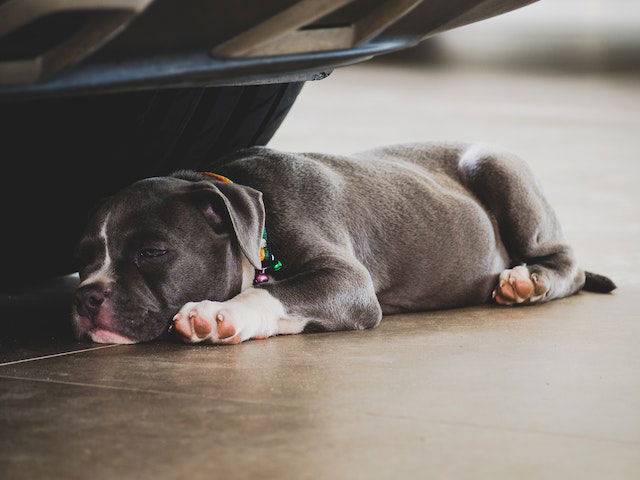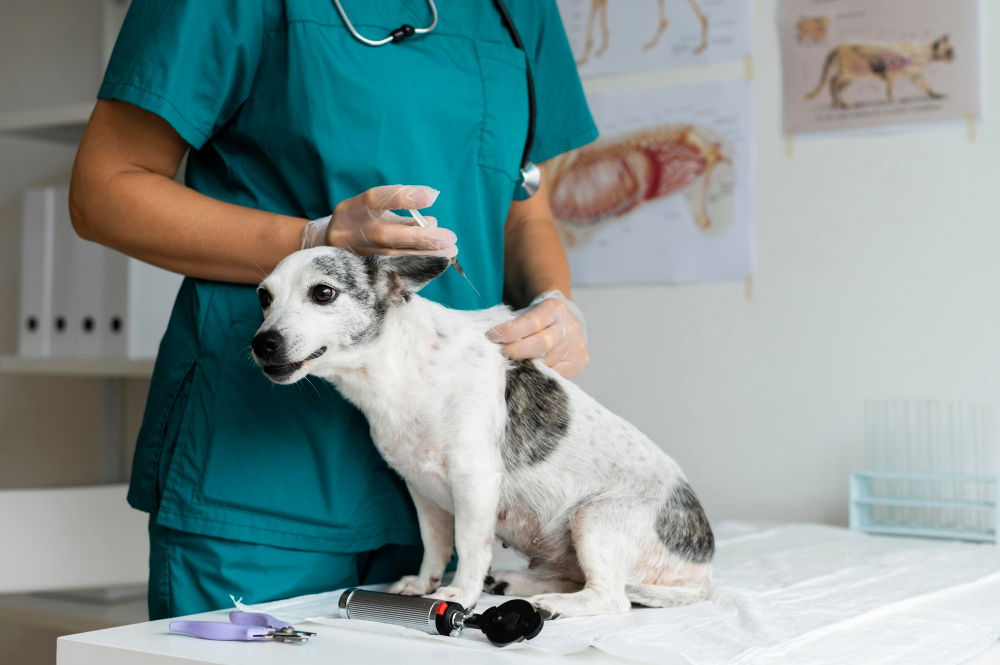We're an affiliate
We hope you love the products we recommend! Just so you know, we may collect a share of sales or other compensation from the links on this page at no additional cost to you. Thank you if you use our links, we really appreciate it!
It may be concerning to wake up in the wee hours of the night, only to see your dog no longer sleeping in their initial spot.
It always seems like some dogs cannot maintain one sleeping spot for an entire night. But, why do some dogs move from spot to spot while sleeping?
There are various reasons why your furry friend may switch spots during sleep, ranging from instinctual behavior to canine sleeping disorders.
In this post, we will explain the common causes of this behavior, offer a profound understanding and provide a practical approach to managing it.
Why Does My Dog Move from Spot to Spot While Sleeping
For the most part, it is quite normal for dogs to shift spots while sleeping. This behavior might be troubling to some dog owners, especially where the movements are so intense.
The following are some of the reasons why your dog is likely to change positions during sleep.
1. It’s a natural instinct
Wild dogs had to move from spot to spot in the woods while sleeping, in order to stay safe from predators such as hyenas.
This kept the dogs vigilant throughout the night and it was a tactic to confuse the predators by regularly shifting locations.
This behavior has since been carried down to our modern dogs, who still rotate through different sleeping spots at home.
Your dog may be switching sleeping spots at night as a way of protecting their personal and territory from other pets.
Our pet dogs are definitely not at risk of predators, but they still feel the urge of moving sleeping positions as an instinctual way of guarding resources and personal space.

2. Discomfort
If your dog’s bed is not soft enough, or the bedding does not provide adequate support, then the dog may be forced to shift positions in search of a comfy spot.
It’s crucial that you create a comfortable sleeping area for your canine friend. This will help them snuggle up in comfort and feel secure in their personal space.
Invest in a high-quality dog bed with the appropriate size for your furry friend, and furnish it with soft bedding for added comfort.
If your dog is advancing in years, you may consider getting an orthopedic memory foam bed to provide superior comfort and extra support to the pressure points.
Cut out a quiet spot in a well-ventilated room to place your dog’s bed. This will give your pup some privacy, quietness, and peace of mind to enjoy a restful night.
You can cover the bed area with a playpen or sizeable crate and add a few interactive toys and accessories such as water bowls, to make your dog ‘own’ the area.
3. For thermoregulation
If your furry friend naps in an area that eventually gets cold, they will certainly shift positions to find a much warmer spot.

During the hot months in the summertime, your dog is likely going to sleep under the bed to keep cold. Most dogs prefer sleeping on cold tiled surfaces to dissipate body heat.
The opposite is seen during the winter where the dog moves positions in search of warmer spots to cuddle up and sleep.
4. Skin Problems
Dog skin conditions that cause itchiness or irritation on their skin can cause poor sleep quality by inducing night walking and movements.
This includes flea and tick infestation which makes it difficult for your pup to settle down and sleep in one area.
Flea bites can irritate the dog and make them jump from one spot to the next in search of comfort and to get away from the parasites.
If you suspect any skin problem on your dog, it is best to address the situation immediately for quicker relief.
In case of flea infestation, your vet may recommend using natural remedies such as essential oils, coconut oil, diatomaceous earth, and Apple cider vinegar to manage the situation.
5. Your dog is dreaming
Sometimes, there’s nothing much to worry about when you wake up in the middle of the night to find your dog shifting spots.
As we saw earlier, dogs have two phases of sleep; REM and non-REM phases. Dreaming happens in the REM cycle where the dog can also exhibit twitching and movement of the eyelids.
If your dog has an eventful day, they’re most likely going to recollect the memories during the dreaming stage in sleep.
A dreaming dog may therefore get twitchy or paddle their limbs while sleeping, and this may cause them to unknowingly slide into a new sleeping position.
6. Environmental distractions
Dogs have a very keen sense of hearing and smell. Strange noises from the environment may disturb your dog during sleep and force them to move from one spot to the next without necessarily waking up.
Human distractions such as walking or noisy neighbors, may also prompt a sleeping dog to wake up and move to a quitter space for quality sleep.
In case of loud noises such as thunderstorms and fireworks, your dog may be woken up and triggered into stress and anxiety, especially during the midnight hours when everyone else is asleep.
Make sure to choose a noise-free environment with ventilation when spacing out a sleeping area for your furry friend.
7. Pent up energy
When a dog is deprived of physical exercises and mental stimulation, they end up finishing the day with lots of pent-up energy.
A dog with high energy levels at night is less likely to fall asleep and when they do, they end up becoming restless and anxious during the night.
Such dogs may wake up in the middle of the night and engage in unpredictable behavior such as barking, chewing, or even biting.
Exercising your dog helps in improving their overall well-being and helping them to have a more restful night with quality sleep.
Exercises don’t have to be tough; daily evening walks and regular hikes are enough to stimulate your dog’s body. Providing puzzle toys may help with mental stimulation.
8. Sleep disorders
Frequent movements during the night may be a sign of canine sleep disorder. Dogs with sleep problems are also likely to get sluggish during the day, cry, whine on their bed, and have difficulty performing basic tasks.
Sleep disorders in dogs will certainly deprive the dog of valuable rest and it may end up causing a buildup of stress hormones (Cortisol).
This may lead to aggressive behavior and the development of other unwanted behaviors in dogs.

Furthermore, lack of quality sleep may weaken the dog’s immune system and expose them to health problems such as bacterial infections.
The common types of sleep disorders in dogs are; sleep apnea, narcolepsy, insomnia, and REM Behavior disorder.
If you suspect the possibility of a sleep disorder affecting your dog, it’s best to visit the vet for a checkup and prompt treatment.
9. Dog Dementia
Canine Cognitive Dysfunction Syndrome (CCD), also known as dog dementia is a cognitive disorder in dogs that resembles Alzheimer’s disease in humans.
This condition is closely related to the aging of an elderly dog’s brain. It typically leads to changes in the dog’s behavior and primarily affects comprehension and learning.
Dogs suffering from cognitive disorders are likely to stare at blank walls (disorientation), change behavior, get restless, and change their sleep cycle.
Frequent visits to the vet for checkups are crucial because this condition can be detected early enough before it progresses to get worst.
There’s no single cure for dementia in dogs, but your vet will recommend medication to keep your pup comfortable.
Dogs with cognitive problems need lifelong therapy and support to keep them healthy and happy.
Your vet will probably advise you to maintain a stimulating environment for your elderly dog through light exercises and mental stimulation. This will ultimately help to slow down the progression of CCD.
Observing And Responding to Your Dog’s Sleeping Behavior
Looking at your dog as they seep can be a loveable moment, especially during those tiny movements in the REM cycle.
It probably gives you satisfaction to know your dog is enjoying sleep and making dreams to recap the day’s activities.
But while at it, you should not be carried away by the appealing sight of unknowing movements in dogs’ sleep.
As we have seen, sometimes dogs will shift their sleeping positions because of severe reasons including restlessness and sleep disorders.
You, therefore, need to assess your dog’s sleeping pattern and behavior to watch out for any signs of restlessness, discomfort, and pain.
In most cases, severe issues in a dog’s sleeping behavior are always accompanied by uneasiness, whining, crying, whimpering, night walking, and even biting.
When To See a Vet
The closest vet’s office should be your first stop once your dog shows signs of having restless nights. This is because unhealthy sleep can be an effect of underlying health problems.
A qualified vet will be able to examine your dog and run diagnostic tests to rule out an inherent medical condition and provide appropriate treatment.

If your dog is suspected to suffer emotional distress and anxiety, your vet will probably recommend anxiety relief medication and recommend appropriate exercise to calm the dog down.
Frequently Asked Questions (FAQs)
1. Should I wake my dog if they are moving too much during sleep?
Many vets recommend against waking your dog unless they’re experiencing clear signs of pain and emotional distress. Dog owners are always advised to ‘let sleeping dogs lie’
Even when it’s justified to wake your dog, you should do so by calmly calling out their name until they respond.
Avoid touching or disrupting your dog during REM sleep because you will startle them and risk getting bitten.
2. How can I create a comfortable sleeping environment for my dog?
Start by getting a comfy dog bed – appropriate for your dog’s size, and furnish it with enough bedding for added coziness.
Place the furnished bed in a quiet room with plenty of ventilation to give your dog some privacy and security.
If your dog is advancing in years, you can consider investing in an orthopedic bed for added comfort and an extra layer of support for achy joints.
It also helps to establish a consistent routine to help your dog recognize bedtime and waking up time. Concentrate your dog’s pre-bedtime routine on petting and soothing session to help them sleep faster.
3. When should I be concerned about my dog’s sleeping behavior?
If your dog becomes restless during sleep and shows some signs of emotional distress, you should make a call to the vet.
If your dog engages in night walking or night vocalizations (such as whining), it should also cause concern to you.
Don’t wait until your dog suffers sleep disorder before acting. Be careful to observe their sleeping patterns and habits and watch out for signs of discomfort.
Conclusion
It may be satisfying to see your dog snuggling up and moving passively during REM sleep. But you may be bothered when the movements are too much.
Movement during sleep in dogs can be due to instincts, discomfort, dreaming, regulating body temperature, an effect of restlessness, or sleep disorder.
Reach out to your vet if you notice any sign of restlessness in sleep, night walking, night vocalization, or signs of disorientation.
You can also improve the quality of your dog’s sleep by giving them healthy foods, providing exercises, and creating a comfortable sleeping area.
Laura is the founder of Furs'n'Paws. She is a also a pet writer and expert with more than 20 years of experience of working with dogs and cats. She developed a very strong love for animals at a young age. Her passion led her to establish a thriving pet sitting and dog walking business in Dubai. As an expert in pet training, behavior, and nutrition, Laura is committed to helping pet owners and pet lovers by offering high-quality information on a wide range of topics.



No responses yet